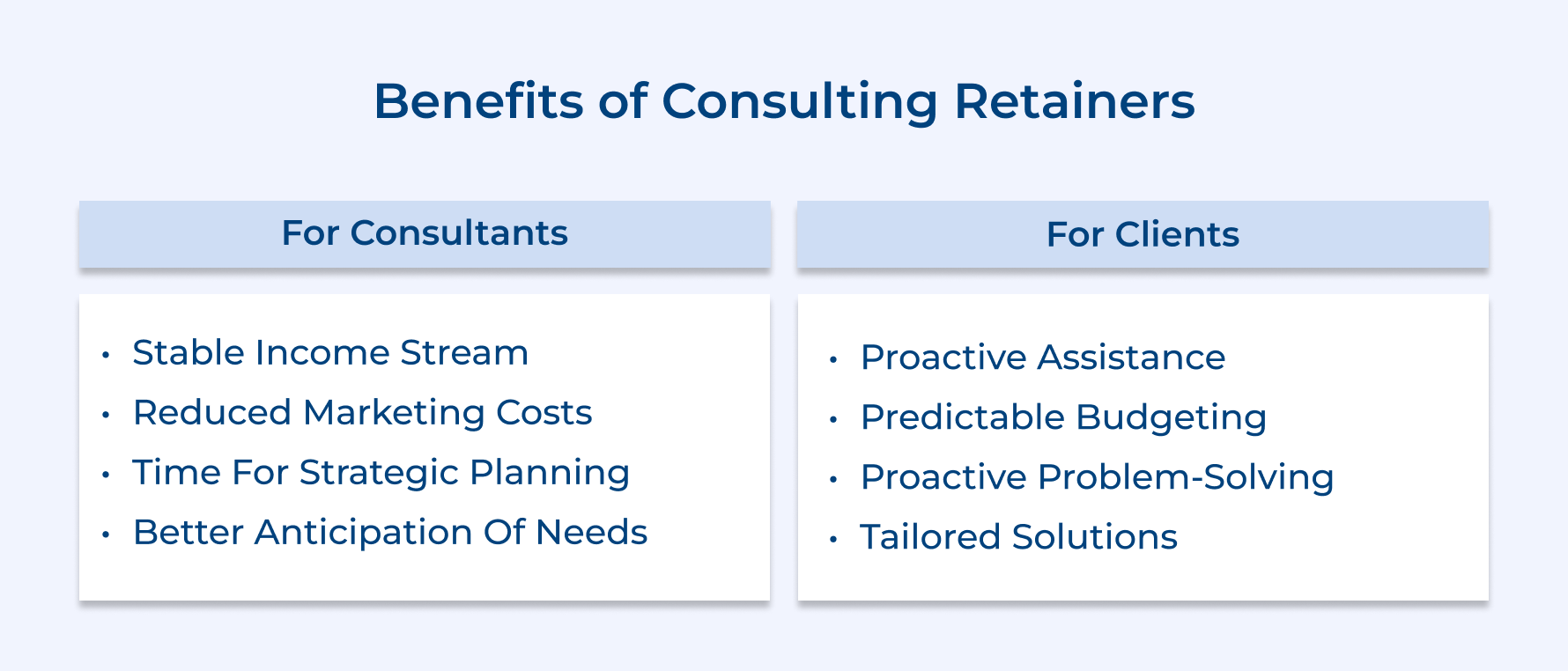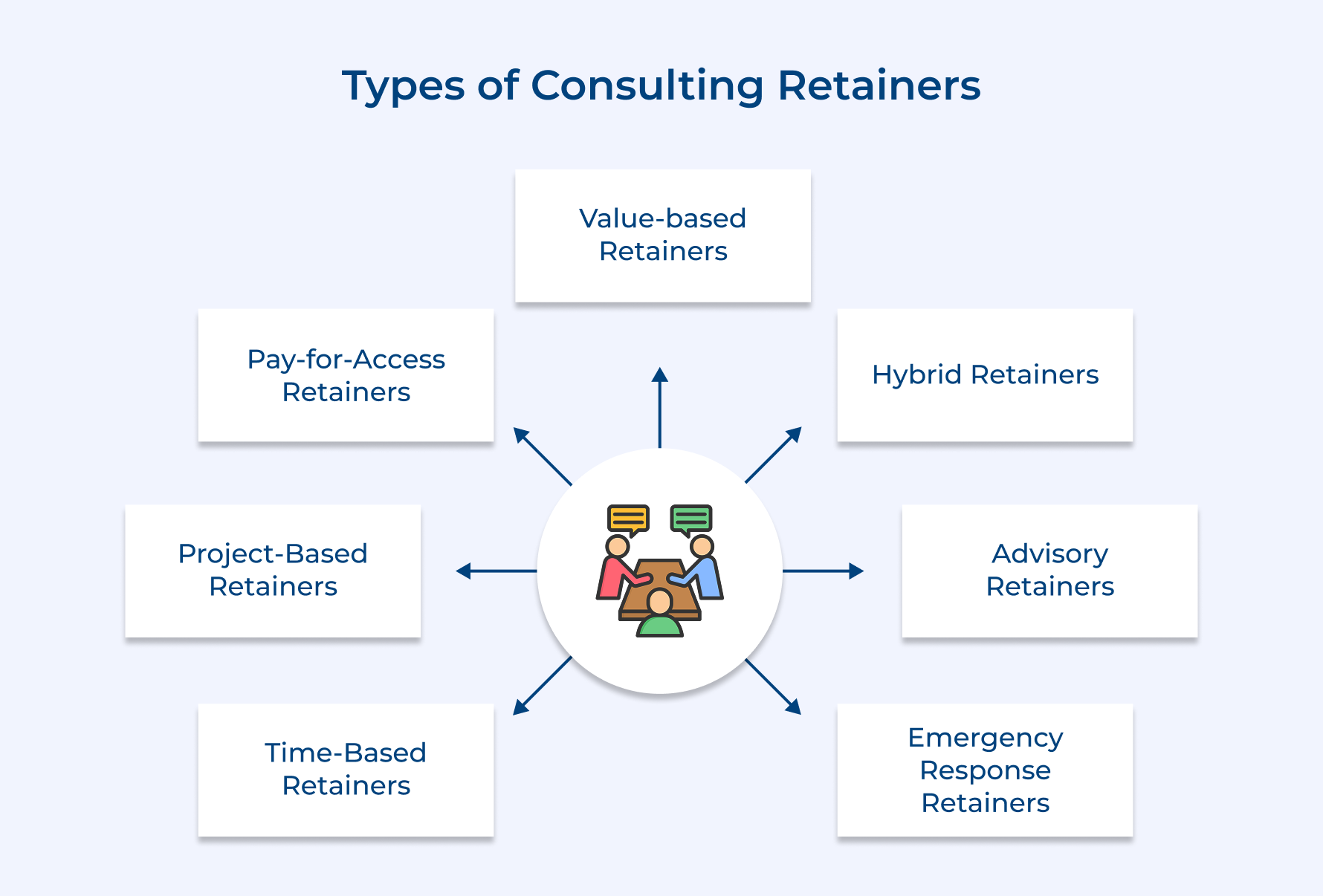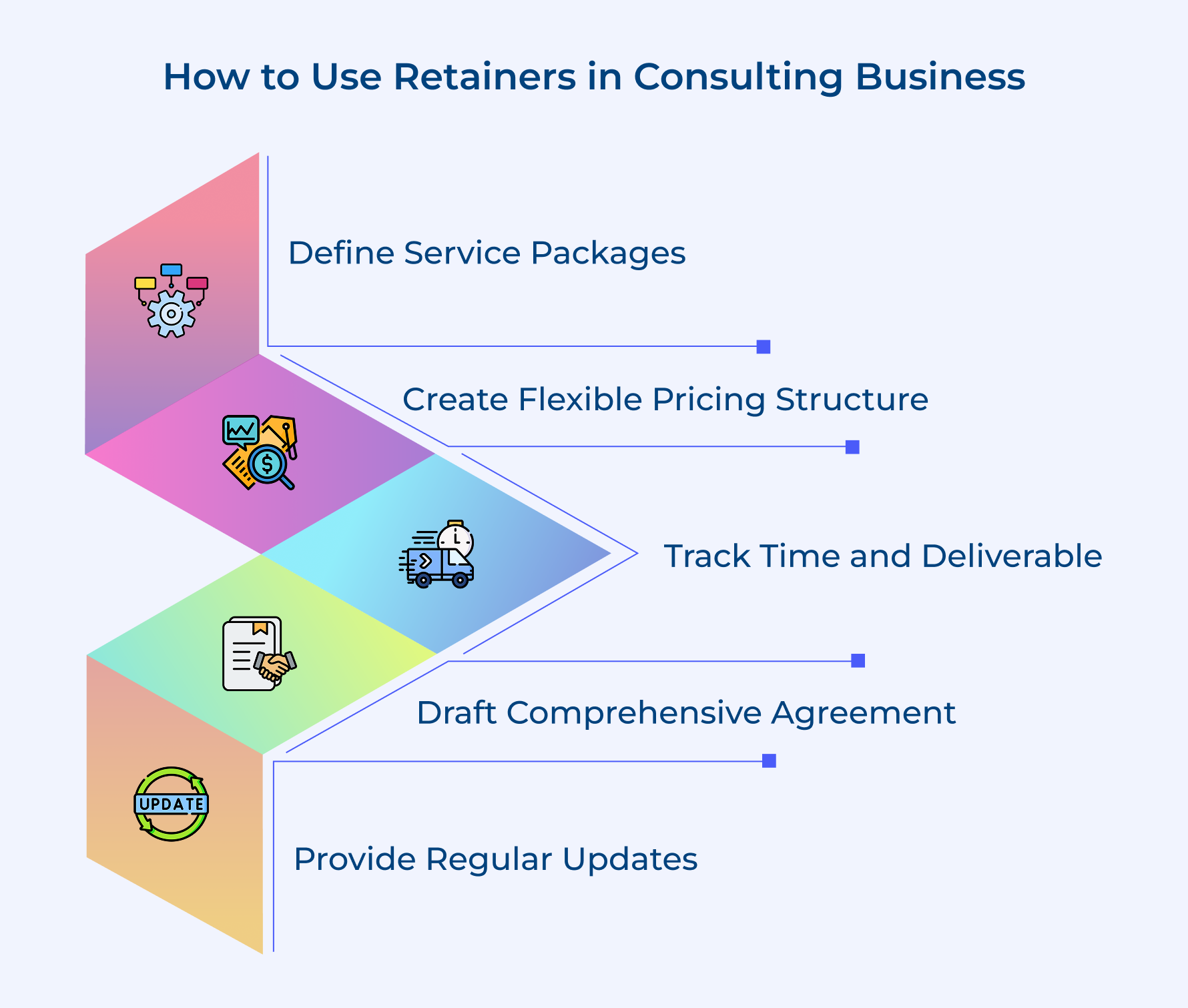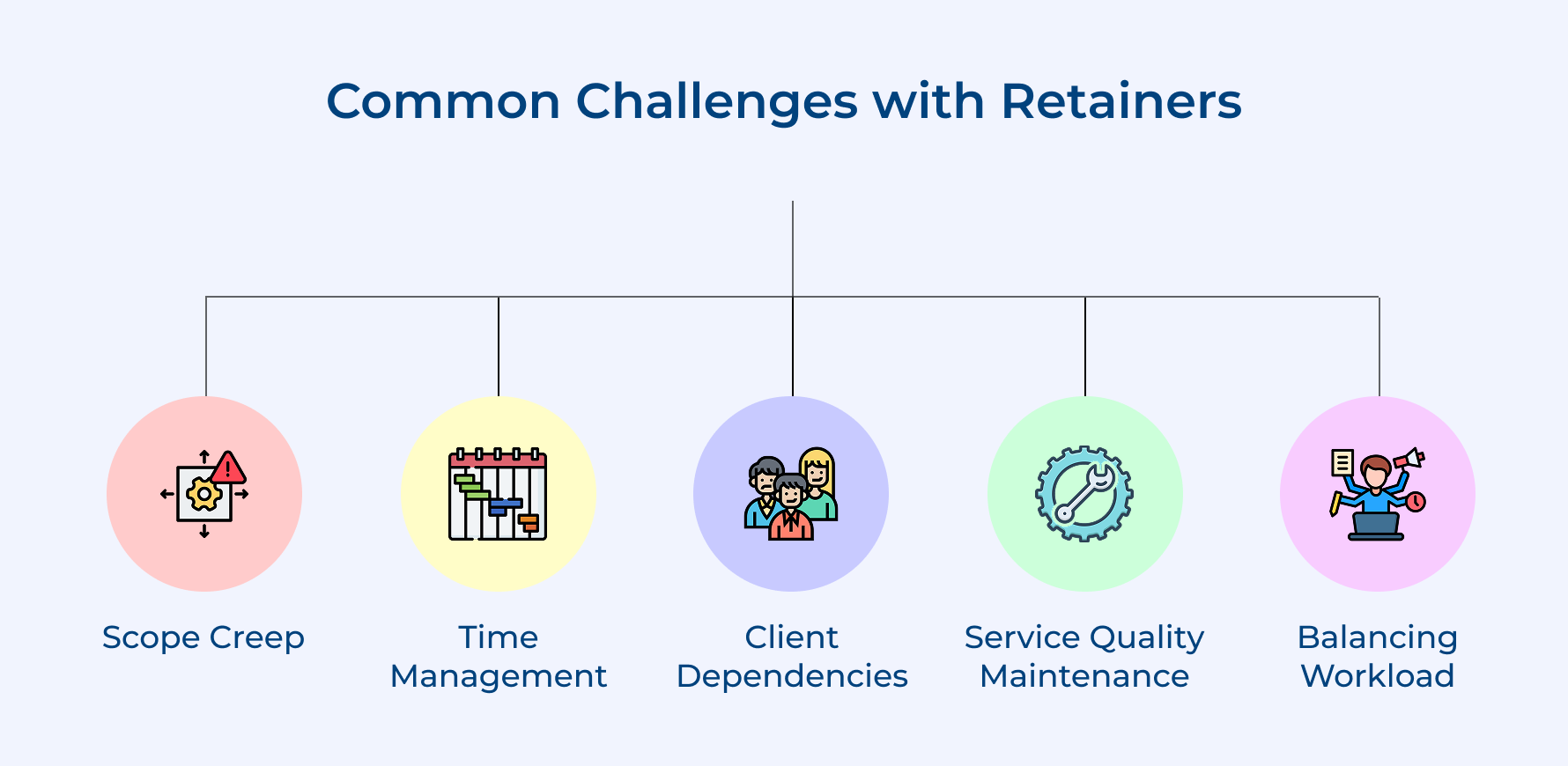Consulting Retainers: Types, Benefits and Best Practices
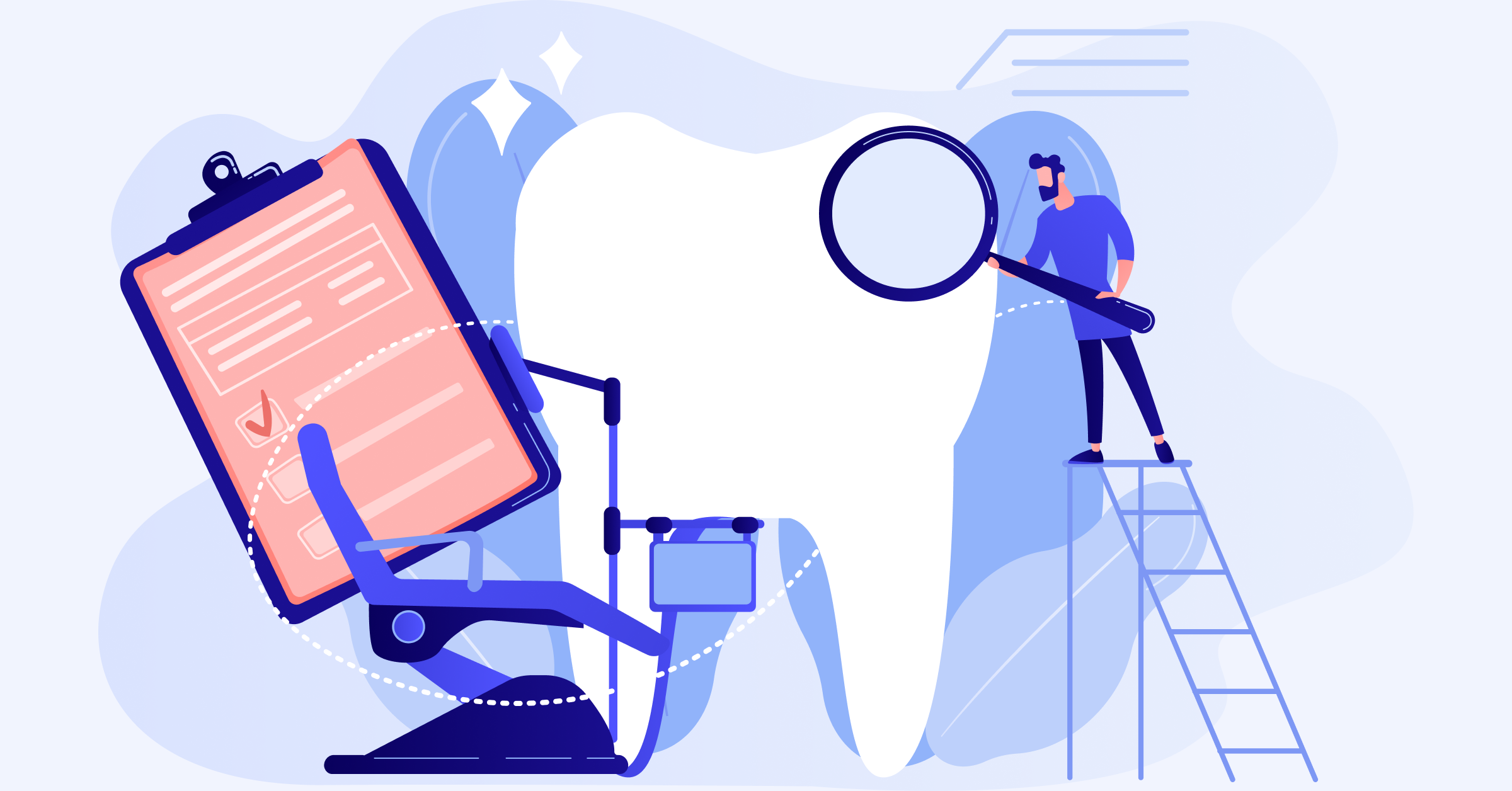
Key Highlights:
- Time-based consulting retainers provide predictable workflows and guaranteed expertise access which are ideal for ongoing support.
- Define service packages with clear deliverables, timelines, and communication to eliminate confusion.
- Structure your packages according to the various levels of client requirements.
Imagine running your consulting business with a steady, predictable income every month—sounds like a dream, right? Well, that’s exactly what retainer agreements can do for you.
With a predictable revenue stream, you can spend less time worrying about chasing the next client and more time crafting tailored solutions that truly meet your clients’ needs. It doesn’t just boost satisfaction but builds trust, paving the way for long-term collaboration.
Let us explore the ins and outs of consulting retainers—what they are, their benefits, the different types, as well as how to make them work for you.
What is a Consulting Retainer?
A consulting retainer is a formal business agreement where a client prepays a consultant or consulting firm a fixed fee to secure their services for a specified period (typically monthly or quarterly).
The arrangement essentially reserves a predetermined amount of the consultant’s time, expertise, and resources, ensuring priority access as well as consistent service delivery.
Retainers also enable consultants to understand a client’s needs and challenges more deeply, leading to tailored as well as effective solutions.
Key objectives:
- Predictable revenue: A retainer establishes a consistent income stream for consultants, enabling better financial planning and stability.
- Client loyalty: Ongoing engagement through retainers builds stronger relationships, encouraging clients to remain loyal and seek additional services.
- Proactive support: With a retainer in place, consultants can offer timely advice, addressing potential issues before they escalate.
- Enhanced collaboration: Regular interaction promotes a deeper understanding of the client’s business, leading to more effective and customized strategies.
Benefits of Consulting Retainers
Consulting retainers provide a stable income stream and build long-term client relationships. However, what other benefits does it have to offer? Let’s delve into them right away!
For consultants, retainers create financial stability while enabling deeper client relationships through sustainable business practices.
1. Stable Income Stream
Monthly retainer revenue guarantees consistent cash flow. Strategic business investments become possible as consultants maintain a focus on delivering exceptional service to current clients.
2. Reduced Marketing Costs
Established retainer clients generate steady work throughout the year. Marketing activities decrease naturally as stable client relationships grow, leading to improved profitability through lower acquisition costs.
3. Time for Strategic Planning
Predictable work schedules empower consultants to manage resources effectively. Regular client patterns create space for professional development while ensuring high-quality deliverables.
4. Better Anticipation of Needs
Long-term partnerships create a deep business understanding. Consultants prepare solutions proactively through sustained knowledge of client operations and industry dynamics.
Businesses gain valuable strategic partnerships through retainer agreements. These relationships ensure reliable expert support for sustained growth.
1. Proactive Assistance
Available consultants provide immediate expertise during critical moments. Quick access prevents minor issues from escalating into significant business challenges.
2. Predictable Budgeting
Fixed monthly fees or sources of income simplify consulting service budgets. Long-term agreements often secure preferential rates compared to individual project costs.
3. Proactive Problem-Solving
Regular consultant engagement reveals potential issues early. Strategic improvements happen naturally through continuous monitoring and expert guidance.
4. Tailored Solutions
Dedicated collaboration builds comprehensive business understanding. Expert knowledge transforms into specific solutions matching unique company objectives and culture.
Types of Consulting Retainers
Various consulting retainer models cater to different client needs, allowing for flexibility and customization. Understanding these types helps optimize client engagement. Here are the types.
1. Time-based Retainers
Think of this as reserving a consultant’s hours each month—it’s like having a go-to expert always available. The approach ensures predictable workflows and resource availability, so you’re never caught off guard. It’s perfect for ongoing support or strategic planning, letting teams tackle projects efficiently without blowing the budget.
2. Project-based Retainers
The retainers here focus on specific deliverables, making progress easy to track. With milestones set each month, your projects move steadily without surprises. The clear boundaries keep scope creep at bay, making this a go-to for content creation, development tasks, or marketing campaigns.
3. Pay-for-access Retainers
Need an expert at your fingertips during high-stakes moments? This model gives you that peace of mind. A quick question or a big decision is never an obstacle with guaranteed availability to keep you moving forward. It’s ideal for fast problem-solving or crisis management when timing is everything.
4. Value-based Retainers
Value-based retainer ties a consultant’s pay directly to results—think performance-based partnerships. Achieving revenue goals or delivering transformational projects requires a focus on measurable outcomes. It’s a great option when you’re looking for consulting success and innovative ideas.
5. Hybrid Retainers
Why settle for one model when you can mix and match? Hybrid retainers combine the best of multiple approaches, making them flexible enough to adapt to your unique business needs. Juggling complex tasks or responding to shifting priorities, this model ensures balance and effectiveness.
6. Advisory Retainers
Imagine having a trusted advisor in your corner, shaping your long-term strategy. Advisory retainers provide regular check-ins with experts who guide your leadership team and help you sidestep common pitfalls. Perfect for businesses aiming for sustainable growth and stronger internal capabilities.
7. Emergency Response Retainers
For those “what if” moments, this model ensures you’re ready to handle crises without missing a beat. Stabilizing operations or navigating urgent challenges becomes seamless with rapid response support to minimize risks and keep your business steady. A must-have for risk management.
How to Use Retainers in Your Consulting Business?
Implementing a retainer model requires clear communication and defined expectations. Here are some quick steps to help you use retainers efficiently whether it’s project basis or revenue one.
1. Define Your Service Packages
When services are well-defined, clients immediately understand what they’re getting, which cuts down on confusion and creates a stronger value proposition.
Offering structured packages allows clients to pick the level of service that fits their needs without guesswork.
Plus, it makes sales conversations smoother and helps set expectations right from the start, avoiding headaches like scope creep later on.
2. Create a Flexible Pricing Structure
Strategic pricing is all about meeting clients where they are while keeping your business profitable.
Offering flexible structures helps you tailor your pricing to match the level of service and support each client needs. This kind of adaptability makes your services appealing to a wider range of clients.
Having multiple payment options ensures steady revenue and keeps things running smoothly.
And when you use value-based pricing, you’re not just charging for hours worked—you’re reflecting the real benefits as well as outcomes your clients gain.
3. Draft a Comprehensive Agreement
Imagine you’re a consultant hired to run a six-month marketing campaign. Your contract spells out the deliverables, like weekly social media posts, monthly reports, and a final campaign analysis. It also defines timelines and how often you’ll check in with the client.
Now, what if halfway through, the client asks for additional work, like managing a separate ad campaign?
If your contract includes clear boundaries and an extra service charge policy, you can handle this request professionally without risking scope creep. It’s all laid out upfront, so there’s no room for confusion or awkward negotiations.
Pro Tip: Include termination clauses (like a 30-day notice) and service-level agreements to outline what’s expected on both sides.
4. Track Time and Deliverables
Systematic tracking ensures proper resource allocation while maintaining service quality. Regular monitoring helps identify efficiency opportunities and potential issues early.
Time tracking supports value demonstration while enabling accurate client reporting. Performance metrics guide improvement efforts.
Implement professional time-tracking tools for accurate billing. Create monthly deliverable checklists for consistent service delivery.
5. Provide Regular Updates
Consistent communication builds client confidence while demonstrating ongoing value. Regular reports showcase progress toward objectives and highlight key achievements.
Proactive updates prevent client concerns while maintaining strong relationships. Clear communication supports retention.
Common Challenges with Retainers
While beneficial, retainer agreements can pose challenges such as scope creep and client expectations. Addressing these issues is crucial for success. Here are the challenges.
Scope Creep: The project scope gradually expands beyond original agreements without additional compensation.
Prevention Strategies:
- Document scope boundaries with specific exclusions while establishing a formal change request process. Monthly scope reviews identify potential creep early.
- Set clear deliverable limits in contracts linked to retainer value. Regular status updates reinforce agreed boundaries.
- Track all client requests against the original scope through detailed activity logs. Immediate discussion of extra requirements maintains transparent relationships.
Time Management: Difficulty balancing multiple retainer commitments on ongoing projects while maintaining responsiveness.
How to Fix:
- Block dedicated time slots for each client using project management tools. Regular schedule reviews ensure balanced attention across all retainers.
- Create priority frameworks defining response times for different request types. Set automated reminders for recurring client commitments.
- Implement time tracking tools measuring actual hours against allocated retainer time. Weekly analysis prevents over-servicing specific clients.
Client Dependencies: Clients become overly reliant on consultant availability for routine tasks.
Resolve it by:
- Building client team capabilities through structured knowledge transfer sessions. Regular skill assessments guide independence development.
- Creating detailed process documentation for routine tasks supporting client self-service. Scheduled training empowers internal teams.
- Establishing clear escalation protocols distinguishing consultant-level needs from routine tasks. A gradual reduction in basic support encourages client growth.
Service Quality Maintenance: Consistency issues arise when juggling multiple long-term commitments.
- Maintain quality through:
- Developing standardized quality checklists for all common deliverables. Regular internal audits maintain service standards.
- Creating templated approaches for recurring deliverables ensuring consistency. Monthly quality reviews identify improvement areas.
- Implementing peer review systems for critical client outputs. Feedback loops drive continuous quality enhancement.
Balancing Workload: Uneven distribution of work throughout retainer periods.
Tips for Solution:
Plan quarterly resource allocation with built-in flexibility periods. Regular capacity reviews prevent over-commitment.
Set maximum client limits based on available team resources. Buffer zones accommodate unexpected urgent requests.
Create backup systems for peak demand periods through reliable partner networks. Cross-training team members enables workload sharing.
Maximizing Value through Consulting Retainers
Consulting retainers significantly impact business growth by building stability and continuity in client relationships. For consultants, reliable income streams allow a focus on delivering high-quality, tailored services without the stress of constant client acquisition. As a result, more time can be dedicated to understanding client needs and refining strategies.
Clients benefit from ongoing access to expertise, ensuring proactive support and timely solutions to challenges. Continuous engagement enhances collaboration, leading to improved performance and increased satisfaction for both parties involved. Retainers enhance operational efficiency while strengthening strategic partnerships
Limit time — not creativity
Everything you need for customer support, marketing & sales.
Neeti Singh is a passionate content writer at Kooper, where he transforms complex concepts into clear, engaging and actionable content. With a keen eye for detail and a love for technology, Tushar Joshi crafts blog posts, guides and articles that help readers navigate the fast-evolving world of software solutions.
